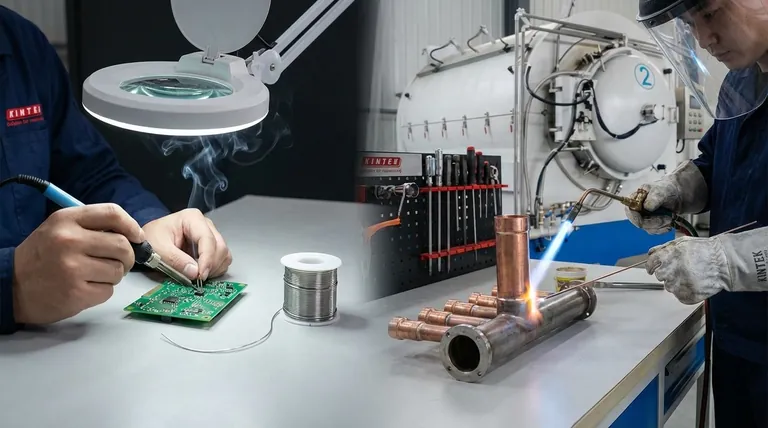At its core, the single defining difference between soldering and brazing is temperature. Both processes join metals using a filler material without melting the base parts, but brazing occurs at high temperatures (above 450°C / 840°F) while soldering is a low-temperature process performed below this threshold. This fundamental distinction in heat directly impacts joint strength, material compatibility, and suitable applications.
Choosing between soldering and brazing is a trade-off between strength and sensitivity. Brazing creates exceptionally strong, structural bonds, while soldering's lower heat makes it the only viable option for delicate, temperature-sensitive components like electronics.

The Defining Factor: Temperature and Filler Metal
The entire classification of these two processes hinges on one internationally recognized temperature. This single variable dictates the type of filler metal used and the resulting characteristics of the joint.
The 450°C (840°F) Threshold
This specific temperature is the formal dividing line. Any process using a filler metal that melts below this point is classified as soldering. Any process using a filler metal that melts above it is classified as brazing.
Soldering: The Low-Temperature Process
Soldering uses filler metals, or solders, that are typically alloys of tin, lead, silver, or other low-melting-point elements. The goal is often to create an electrical connection rather than a high-strength mechanical bond.
Brazing: The High-Temperature Process
Brazing uses filler alloys with much higher melting points, often containing silver, copper, nickel, or aluminum. The greater heat involved facilitates a stronger metallurgical bond between the filler and the base metals through a process called capillary action.
Why This Difference Matters: Strength and Application
The significant gap in operating temperatures creates two very different tools for two very different sets of problems. One is built for strength, the other for delicacy.
Joint Strength: A Clear Distinction
Brazed joints are dramatically stronger than soldered joints. A properly brazed joint can be as strong, or even stronger, than the base metals it is connecting. This makes it suitable for structural applications that must bear significant stress or vibration.
In contrast, a soldered joint is comparatively weak. Its primary purpose is typically for adhesion and electrical conductivity, not mechanical load-bearing.
Common Applications for Soldering
The low heat of soldering makes it ideal for components that would be damaged by high temperatures. Its most common use is in electronics for attaching components to printed circuit boards (PCBs). It is also used in plumbing for joining copper pipes and in decorative arts like stained glass.
Common Applications for Brazing
Brazing's strength makes it a staple in industrial manufacturing. It is widely used in the automotive industry for components like radiators and air conditioning systems, in HVAC, and for joining parts in tools and heavy equipment.
Understanding the Trade-offs
Choosing a method isn't just about picking the strongest option. The high heat required for brazing introduces critical limitations that you must consider.
The Risk of Heat Damage
The primary advantage of soldering is also the primary drawback of brazing: heat. The high temperatures of brazing can easily damage or distort thin, delicate, or previously heat-treated base materials, making the process unsuitable for sensitive applications.
Process Complexity and Equipment
Soldering is generally a simpler process, often achievable with a basic soldering iron or torch. Brazing requires more precise temperature control and more powerful heat sources, which can increase complexity and cost.
Material Compatibility
While both can join dissimilar metals, brazing is generally more versatile. The high heat and specialized filler alloys allow for strong bonds between a very wide range of materials, such as steel to copper or tungsten carbide to steel.
Making the Right Choice for Your Application
Ultimately, the choice depends entirely on the demands of your specific project.
- If your primary focus is electrical conductivity or joining heat-sensitive components: Soldering is the correct choice due to its low-temperature application.
- If your primary focus is maximum joint strength for structural parts: Brazing is superior, creating a bond that is often as strong as the materials being joined.
- If your primary focus is joining dissimilar or high-strength metals: Brazing provides a more robust and reliable solution for challenging material combinations.
Understanding this fundamental trade-off between heat, strength, and component sensitivity is the key to selecting the right joining process for your work.
Summary Table:
| Feature | Soldering | Brazing |
|---|---|---|
| Process Temperature | Below 450°C (840°F) | Above 450°C (840°F) |
| Joint Strength | Lower (for adhesion/electrical) | High (structural, as strong as base metals) |
| Primary Applications | Electronics, plumbing, delicate components | Automotive, HVAC, heavy equipment |
| Heat Sensitivity | Ideal for heat-sensitive parts | Risk of damaging delicate materials |
Need expert advice for your metal joining applications? The right equipment is crucial for achieving perfect soldering or brazing results. KINTEK specializes in high-performance lab equipment and consumables for all your thermal processing needs. Our solutions ensure precise temperature control and reliable performance for both delicate electronic assemblies and robust industrial brazing.
Let our experts help you select the ideal equipment for your specific requirements.
Contact us today to discuss how KINTEK can enhance your laboratory's capabilities and efficiency!
Visual Guide

Related Products
- Vacuum Heat Treat Sintering Brazing Furnace
- Thermally Evaporated Tungsten Wire for High Temperature Applications
- Vacuum Heat Treat and Molybdenum Wire Sintering Furnace for Vacuum Sintering
- Custom-Made Alumina Zirconia Special-Shaped Ceramic Plates for Engineering Advanced Fine Ceramics Processing
- Vacuum Hot Press Furnace Heated Vacuum Press Machine Tube Furnace
People Also Ask
- What are the different types of brazing welding? A Guide to Choosing the Right Heat Source
- What is brazing in heat treatment? Achieve Superior Joint Quality and Efficiency
- Can dissimilar metals be brazed or braze welded? A Guide to Strong, Reliable Joints
- What is the process of a vacuum furnace? Achieve Purity and Precision in High-Temp Processing
- What are vacuum furnaces used for? Unlock Ultimate Material Purity and Performance

























